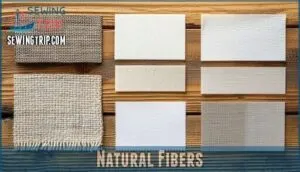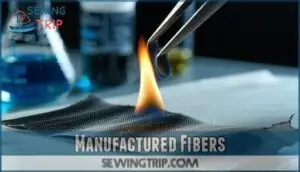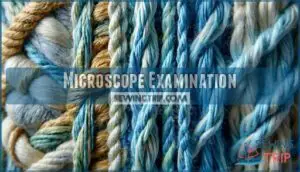This site is supported by our readers. We may earn a commission, at no cost to you, if you purchase through links.

Start with visual inspection – cotton looks matte while silk has a natural sheen.
The burn test is your secret weapon: cotton burns like paper with white ash, while polyester melts into hard beads and smells like chemicals.
Use a magnifying glass to examine fiber structure – natural fibers look irregular, synthetic ones appear uniform.
Consider the fabric’s age and origin for context clues.
Check how it feels after washing – does it shrink or stay the same?
These techniques work together like puzzle pieces, each revealing clues about your fabric’s true identity and helping you make informed decisions about care and use.
Table Of Contents
Key Takeaways
- Use the burn test as your primary identification method – You’ll get instant results by observing how fabric burns, smells, and what ash it leaves behind
- Start with visual inspection to narrow down possibilities – You can quickly distinguish natural from synthetic fibers by examining texture, sheen, and drape behavior
- Combine multiple testing methods for accuracy – You’ll need to use burn tests, microscope examination, and washing behavior together since single tests can be misleading
- Test small samples safely before making care decisions – You can avoid damaging entire garments by testing fabric response to heat, water, and washing on small pieces first
Visual Inspection
Visual inspection serves as your first line of defense when identifying mystery fabrics.
Start by examining the fabric’s texture—does it feel smooth like silk or rough like burlap?
Study the weave patterns closely, noting whether threads cross in a simple over-under pattern or create complex designs.
Color analysis reveals important clues about the fabric’s origin and processing methods.
Watch how the material behaves during drape observation—silk flows gracefully while cotton hangs more stiffly.
Look for telltale signs like the lustrous sheen of satin or the fuzzy surface of flannel.
Fiber identification becomes easier when you spot distinctive visual markers like cotton’s matte appearance or polyester’s artificial gleam.
This systematic visual inspection provides essential data points that’ll guide your fabric identification process before moving to more advanced testing methods.
Burn Test
The burn test is one of the fastest ways to identify unknown fabrics by observing how they react to flame.
A simple flame test reveals your fabric’s true identity in seconds.
You’ll examine the smell, flame color, and ash residue to determine whether you’re dealing with natural or synthetic fibers, using the burn test.
Natural Fibers
When testing natural fibers through fabric identification, you’ll notice distinct burning characteristics that make fiber analysis straightforward.
Cotton Properties include rapid ignition with yellow flames and a paper-like scent, producing soft gray ash. Linen Characteristics mirror cotton’s quick burn but smell more like burning leaves.
Wool Varieties burn slowly, self-extinguish, and emit a burning hair odor while forming crushable black ash. Silk Production creates fibers that char and curl away from flames, smelling like burnt hair and leaving brittle black beads.
These Plant Fibers and animal fibers provide reliable identification markers through their unique burn patterns, making natural fiber detection simple through visual inspection and touch identification techniques.
Manufactured Fibers
Manufactured fibers show distinct burn patterns that help with fabric identification. Unlike natural fibers, synthetic fibers typically melt before burning, creating characteristic beads and chemical odors.
Here’s what to watch for during burn tests:
- Polyester – Melts and shrinks from flame, burns slowly with black smoke, leaves hard plastic beads, smells sweet or fruity
- Nylon – Melts rapidly, self-extinguishes, produces celery-like odor, forms hard gray beads
- Acrylic – Burns quickly while sputtering, continues burning, smells acidic, creates hard black residue
Synthetic blends combine fiber production techniques, affecting fabric performance differently than pure materials.
Microscope Examination
Under the microscope’s watchful eye, fabric secrets come into sharp focus.
Microscope examination reveals fiber morphology—cotton’s twisted ribbon shape, wool’s overlapping scales, and silk’s smooth rod structure.
Study weave patterns closely, noting how threads interlace and their spacing.
Examine yarn density by counting threads per inch in both warp and weft directions.
Look for flaw detection clues like snags, slubs, or irregular spots that hint at manufacturing methods.
Natural fibers show variable diameters and surface textures, while synthetics appear uniform with smooth, consistent shapes.
Cotton fibers measure 16-20 microns with convoluted structures, whereas polyester displays circular cross-sections.
Knowing the content helps with proper care decisions.
Compare your observations against reference images in fabric guides.
This systematic fabric analysis approach helps distinguish between fiber types through detailed yarn examination, making fabric identification more reliable than guesswork alone.
Consider Fabric Origin and Age
A fabric’s age and origin can reveal important clues about its composition and quality.
Older fabrics might show wear patterns that help distinguish natural from synthetic materials, while knowing where a fabric came from can narrow down likely fiber types.
Test Fabric Burn Behavior
After examining fabric structure under magnification, you’ll want to confirm your findings through direct flame testing. The burn test remains one of the most reliable fabric identification techniques for determining fiber composition.
Cut a small fabric sample and hold it with tweezers for safety. Light the swatch and watch how it behaves – this reveals everything about your fabric’s true nature. Different fibers create distinct flame characteristics that act like fingerprints for identification.
Here’s what to observe during your fabric burn test:
- Flame behavior – Cotton ignites quickly with yellow flames, while polyester melts and shrinks away
- Smoke color – Natural fibers produce light smoke; synthetics create thick, dark clouds
- Odor identification – Cotton smells like burning leaves, silk like burnt hair, polyester sweet and fruity
- Ash analysis – Natural fibers leave soft gray powder; synthetics form hard plastic beads
- Residue texture – Crush the cooled ash between fingers to feel its consistency and structure
This method works because each fiber type has unique chemical properties that create predictable burning patterns, making fabric identification straightforward and accurate.
– Microscope Fabric Inspection
Fiber morphology becomes crystal clear under magnification, revealing the textile’s true identity.
Your fabric microscope transforms guesswork into scientific certainty.
Examine yarn structure, weave patterns, and fiber shapes against reference images.
Look for flaws like snags or irregular threading.
A quality inspection tool is essential for detailed analysis.
Visual inspection through magnification provides definitive answers when other fabric identification techniques fall short.
– Online Fabric Identification Guide
When traditional fabric identification methods leave you stumped, online fabric guides offer digital solutions.
Modern fabric identification relies on these digital resources:
- Image recognition apps – Upload photos for instant fabric analysis and matching
- Expert verification platforms – Connect with textile professionals for difficult identifications
- DIY methods databases – Access extensive burn test and visual comparison charts
- Mobile apps – Use smartphone tools for on-the-go fabric identification
- Visual guide libraries – Browse extensive fabric samples with detailed descriptions
These online fabric identification methods complement hands-on testing, giving you multiple verification paths for unknown textiles.
Consider fabric weight implications when choosing material.
Check Fabric Condition
Your fabric’s condition tells a story that’s key to accurate fabric identification. Start by gently stretching the material to test its elasticity – natural fibers like cotton lose bounce over time, while synthetics often maintain their stretch longer.
This simple test reveals clues about fiber degradation and fabric age. Examine weave integrity by looking for loose threads, snags, or areas where the structure appears compromised.
Check for pilling potential by running your fingers across the surface – wool and cotton blends often show tiny balls of fiber, while high-quality synthetics resist this issue. Assess color fading patterns, as different fibers fade uniquely.
Cotton typically fades evenly, while polyester holds color longer. Look for stain resistance evidence – synthetic fabrics often repel spills better than natural ones.
During your visual inspection, note fabric damage like holes, tears, or brittleness that indicate specific fiber types and their typical aging patterns. This detective work provides valuable fabric identification clues.
Test Washing, Drying, Ironing Behavior
When you’ve checked the fabric’s condition, it’s time to put it through the ultimate test—washing, drying, and ironing. This laundering behavior reveals critical clues about fabric composition that visual inspection might miss.
Start with shrinkage testing using a small sample. Cotton fabrics routinely shrink 2-10% after the first wash cycle, while polyester maintains its original shape with less than 1% shrinkage. Wool can shrink up to 30% if you’re not careful with hot water.
To perform accurate tests, consider investing in fabric shrinkage equipment. Next, assess colorfastness by washing samples in different temperatures. Synthetic fibers like polyester retain color better than natural fibers, which may fade within 5-10 washes.
Silk shows significant color bleeding without cold water treatment. Test drying methods too. High heat causes noticeable shrinkage in cotton and linen but leaves polyester unaffected.
For ironing temperature tolerance, cotton withstands up to 200°C while silk risks damage above 140°C. These fabric washing, fabric drying, and fabric ironing responses provide definitive identification clues.
Frequently Asked Questions (FAQs)
Is there a way to identify a fabric?
When in doubt, look closer" – you can identify fabrics through three main methods:
Burn tests reveal fiber type through flame behavior and smell, visual inspection shows texture and weave patterns, and water tests demonstrate absorption properties.
Water tests demonstrate absorption properties.
Can I take a picture of fabric and find it?
Taking photos of fabric alone won’t directly identify the material.
You’ll need apps that combine image recognition with fabric databases, but results aren’t always reliable.
Physical testing methods like burn tests remain more accurate.
How to identify original fabric?
Original fabric identification starts with examining burn patterns, feeling texture, and checking water absorption.
You’ll use visual inspection for weave patterns, combined with microscopic analysis to reveal whether it’s cotton, silk, wool, or synthetic materials.
These techniques reveal whether it’s made of other materials, and synthetic materials can be identified through these methods.
Can fabric blends be identified accurately?
You can identify fabric blends, but it’s trickier than single fibers.
Burn tests show mixed characteristics – cotton-polyester might melt and flame simultaneously.
Water absorption varies depending on blend ratios, making precise identification challenging.
What tools besides microscopes help identification?
Beyond the microscope’s revealing lens, you’ll find handy helpers for fabric detective work. Use burn tests, water droplet tests, bleach solutions, and simple touch comparisons to crack the textile code.
How do fabric treatments affect identification?
Fabric treatments like starching, flame retardants, and waterproofing can mask natural characteristics. You’ll notice altered burn patterns, unusual odors, or unexpected water resistance that throws off standard identification methods.
Can damaged fabrics still be identified?
Even when torn, faded, or stained, you can still identify fabrics using multiple techniques. Burn tests remain effective since fiber composition doesn’t change. Microscopic examination works on small undamaged sections.
What about vintage or antique fabrics?
Vintage fabrics can be identified using the same techniques, but you’ll need extra care.
Age makes fibers more fragile, so use smaller samples for burn tests.
Older synthetic materials might behave differently than modern versions due to manufacturing changes over time.
Conclusion
Mastering how to identify fabrics transforms you from guessing at care labels to confidently understanding your textiles.
While synthetic fabrics might fool you with their cotton-like appearance, natural fibers reveal their secrets through these six detective methods.
You’ll save money by avoiding shrinkage disasters and extend garment life through proper care.
Whether examining vintage finds or modern blends, these identification techniques give you the knowledge to treat each fabric appropriately and make informed purchasing decisions, helping you to confidently understand and extend garment life.












